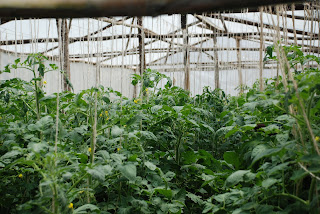by Edgars Skvariks
 |
| Photo by Edgars Skvariks |
Rawal region is one of the first areas in Kenya where farmers have joined together and started to build greenhouses. Most of the villagers still deride and are little confused - why does someone in Africa needs to make a greenhouse to make hot and humid climate? But Martin Omondi Onyango, the farmer who built the wood-framed greenhouses with his own hands, is a village hero. Carrying a huge machete in his hands, he starts speaking about his construction. “Just two to three months after planting tomato seeds, we can already have a harvest. They grow in a controlled environment, protected from thieves, wild animals, plant diseases and parasites”, he adds.
 |
| Martin Omondi Onyango. Photo by Edgars Skvariks |
The greenhouse features some additional innovation – an irrigation system that works regardless of the weather, because right next to the building a rain water collector is installed. So far, 26 year old greenhouse owner Martin Omondi Onyango had grown tomatoes in the field. He could harvest only three tomatoes from one branch. But thanks to the greenhouse yields have increased threefold.
Thanks to the village farmer diligence, the vegetables and domestic product prices have fallen. This means that the region school feeding program has become a bit cheaper and will probably continue for a longer time.
 |
| Onyango's greenhouse. Photo by Edgars Skvariks. |
Food efficiency in Africa is a huge problem since it impacts education. Hungry children cannot focus on learning and they develop health problems. Adequate nutrition is critically important during the first 1000 days of a child’s life. Even though at least 70% of Africans are engaged in agriculture, the number of people who suffer from malnutrition has increased from 100 million in the 1990s to 250 million today. It is known that over the last 40 years global food production has increased by 145%, but not in Africa. Food production has decreased here with 10% in the same time period.
A rapidly expanding population against a decrease in the food production rate doesn’t only mean 50 years of stagnation. This means that some parts of Africa are excluded from world events and that the continent is in need of innovations and creative solutions just like Martin’s greenhouses.

Innovative greenhouses
ReplyDelete--------------------
شركة تنظيف بالخرج